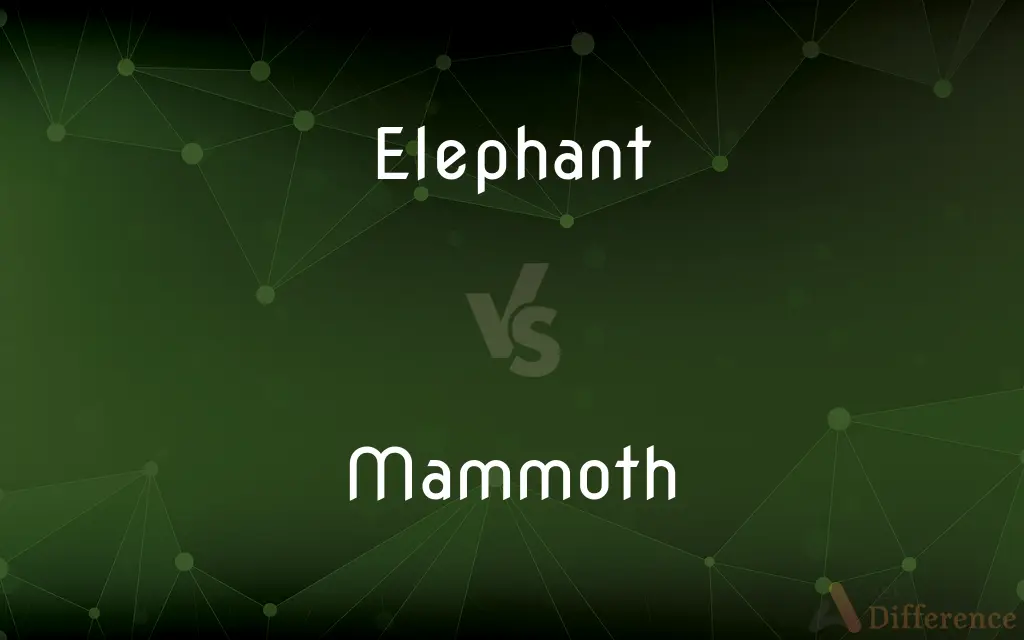Elephant vs. Mammoth — What's the Difference?
By Tayyaba Rehman — Updated on October 27, 2023
Elephants are large mammals currently inhabiting parts of Africa and Asia. Mammoths were prehistoric relatives of elephants, now extinct, with long, curved tusks and thick, hairy coats.

Difference Between Elephant and Mammoth
Table of Contents
ADVERTISEMENT
Key Differences
Elephants are one of the largest living terrestrial animals, with species like the African and Asian elephants roaming various terrains today. They have long trunks and, in many cases, large tusks, which are used for a variety of tasks and can be seen in both males and females. Mammoths, on the other hand, existed during the Pleistocene era and were equipped with long, spiraled tusks and a thick coat of hair to withstand colder climates.
The habitats of Elephants and Mammoths differed significantly. While elephants today can be found in diverse ecosystems like savannas, forests, and deserts, mammoths primarily inhabited the colder regions of Europe, Asia, and North America. Their thick fur and layer of fat ensured their survival in these harsh environments.
One of the most significant differences between Elephants and Mammoths is their evolutionary timeline. While Elephants have evolved and continue to thrive, though facing threats from habitat loss and poaching, Mammoths became extinct approximately 4,000 years ago. Numerous factors contributed to their extinction, including climate change and human hunting.
Though Elephants and Mammoths share a lot of genetic similarities, being part of the Elephantidae family, their physical characteristics set them apart. Elephants have larger ears, especially the African species, which help in heat dissipation. Mammoths, contrastingly, had a pronounced hump of fat behind their heads, providing energy and warmth.
Comparison Chart
Current Existence
Still exist and roam parts of Africa and Asia.
Extinct, last seen around 4,000 years ago.
ADVERTISEMENT
Coat
Mostly hairless, thick skin.
Thick, hairy coat for cold climates.
Tusks
Present in both males and females, not always spiraled.
Long, spiraled tusks.
Habitat
Savannas, forests, and deserts.
Cold regions of Europe, Asia, and North America.
Physical Features
Large ears, especially in African elephants.
Smaller ears, hump of fat behind the head.
Compare with Definitions
Elephant
The largest land animal existing today.
Elephants play a vital role in maintaining ecological balance.
Mammoth
A prehistoric, hairy relative of the modern elephant.
Scientists found a well-preserved Mammoth in Siberian ice.
Elephant
A symbol of strength and power in various cultures.
The Elephant statue at the entrance symbolizes protection.
Mammoth
Inhabited cold regions during the Pleistocene era.
Climate change played a role in the Mammoth's extinction.
Elephant
Known for its intelligence and memory.
It's said an Elephant never forgets.
Mammoth
Larger in size compared to many of today's elephants.
The sheer size of the Mammoth is depicted in many ancient cave paintings.
Elephant
A large herbivorous mammal with a trunk.
The Elephant used its trunk to drink water from the river.
Mammoth
An extinct species with significant cultural importance.
Ancient civilizations depicted the Mammoth in various artworks.
Elephant
Endangered due to poaching and habitat loss.
Conservation efforts are underway to protect the Elephant population.
Mammoth
Known for its long, curved tusks.
The Mammoth's tusks were used for various tasks, including digging.
Elephant
Elephants are a select group of proboscideans belonging to the family Elephantidae. They are the largest existing land animals.
Mammoth
A mammoth is any species of the extinct elephantid genus Mammuthus, one of the many genera that make up the order of trunked mammals called proboscideans. The various species of mammoth were commonly equipped with long, curved tusks and, in northern species, a covering of long hair.
Elephant
Any of several very large herbivorous mammals of the family Elephantidae native to Africa, South Asia, and Southeast Asia, having thick, almost hairless skin, a long, flexible, prehensile trunk, upper incisors forming long curved tusks of ivory, and, in the African species, large fan-shaped ears.
Mammoth
Any of various extinct elephants of the genus Mammuthus of the Pliocene, Pleistocene, and Holocene Epochs, having ridged molars and often, as in the woolly mammoth, long tusks and hair.
Elephant
Any of various extinct animals of the family Elephantidae.
Mammoth
Something that is of great size.
Elephant
A mammal of the order Proboscidea, having a trunk, and two large ivory tusks jutting from the upper jaw.
Mammoth
Of enormous size, extent, or amount; huge.
Elephant
(in particular) Any member of the subfamily Elephantinae not also of the genera Mammuthus and Primelephas.
Mammoth
Of great scope or importance
Mammoth expectations.
Elephant
(figuratively) Anything huge and ponderous.
Mammoth
Any species of the extinct genus Mammuthus, of large, usually hairy, elephant-like mammals with long curved tusks and an inclined back, which became extinct with the last retreat of ice age glaciers during the late Pleistocene period, and are known from fossils, frozen carcasses, and Paleolithic cave paintings found in North America and Eurasia.
Elephant
Synonym of elephant paper
Mammoth
(obsolete) A mastodon.
Elephant
Used when counting to add length, so that each count takes about one second
Let's play hide and seek. I'll count. One elephant, two elephant, three elephant...
Mammoth
(figuratively) Something very large of its kind.
Elephant
Ivory.
Mammoth
Comparable to a mammoth in its size; very large, huge, gigantic.
Elephant
(xiangqi) A xiangqi piece, that is moved two points diagonally, may not jump over intervening pieces and may not cross the river.
Mammoth
An extinct, hairy, maned elephant (Mammuthus primigenius formerly Elephas primigenius), of enormous size, remains of which are found in the northern parts of both continents. The last of the race, in Europe, were coeval with prehistoric man.
Elephant
A mammal of the order Proboscidia and family Elephantidae, of which two living species, Elephas maximus (formerly Elephas Indicus) and Loxodonta Africana (formerly E. Africanus), and several fossil species, are known. They have five toes, a long proboscis or trunk, and two large ivory tusks proceeding from the extremity of the upper jaw, and curving upwards. The molar teeth are large and have transverse folds. Elephants are the largest land animals now existing. The elephant is classed as a pachyderm.
Mammoth
Resembling the mammoth in size; very large; gigantic; as, a mammoth ox.
Elephant
Ivory; the tusk of the elephant.
Mammoth
Any of numerous extinct elephants widely distributed in the Pleistocene; extremely large with hairy coats and long upcurved tusks
Elephant
Five-toed pachyderm
Mammoth
So exceedingly large or extensive as to suggest a giant or mammoth;
A gigantic redwood
Gigantic disappointment
A mammoth ship
A mammoth multinational corporation
Elephant
The symbol of the Republican Party; introduced in cartoons by Thomas Nast in 1874
Common Curiosities
Are Elephants and Mammoths the same?
No, Elephants are modern mammals while Mammoths were their prehistoric relatives.
Where did Mammoths live?
Mammoths primarily inhabited the colder regions of Europe, Asia, and North America.
Are Elephants endangered?
Yes, particularly due to poaching and habitat loss.
Why did the Mammoth go extinct?
A combination of climate change and human hunting contributed to their extinction.
Do Elephants have fur like Mammoths?
No, Elephants have mostly hairless, thick skin, while Mammoths had a thick, hairy coat.
How do Elephants use their tusks?
For digging, fighting, lifting objects, and gathering food.
Did Mammoths live with humans?
Yes, early humans coexisted with Mammoths and even hunted them.
Are there any living descendants of the Mammoth?
Elephants are the closest living relatives of Mammoths.
Where can you find Elephants today?
In parts of Africa and Asia, including national parks and wildlife reserves.
What do Elephants eat?
They are herbivores, consuming grass, fruits, and tree bark.
Were Mammoths bigger than Elephants?
Some species of Mammoths were larger than modern Elephants, but size varied among species.
Are all Mammoth species the same?
No, there were different species, like the Woolly Mammoth and the Columbian Mammoth.
Share Your Discovery

Previous Comparison
Entailment vs. Presupposition
Next Comparison
Pupil vs. StudentAuthor Spotlight
Written by
Tayyaba RehmanTayyaba Rehman is a distinguished writer, currently serving as a primary contributor to askdifference.com. As a researcher in semantics and etymology, Tayyaba's passion for the complexity of languages and their distinctions has found a perfect home on the platform. Tayyaba delves into the intricacies of language, distinguishing between commonly confused words and phrases, thereby providing clarity for readers worldwide.














































